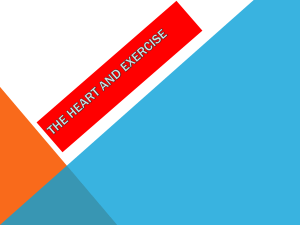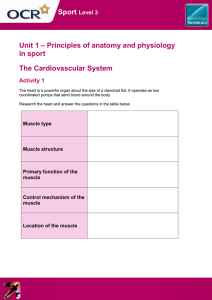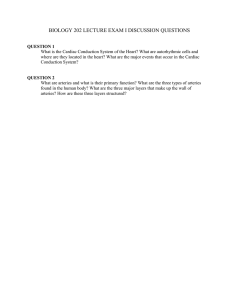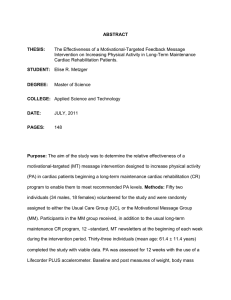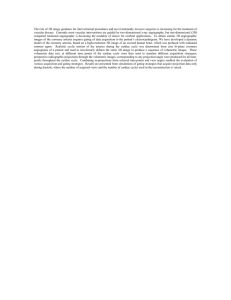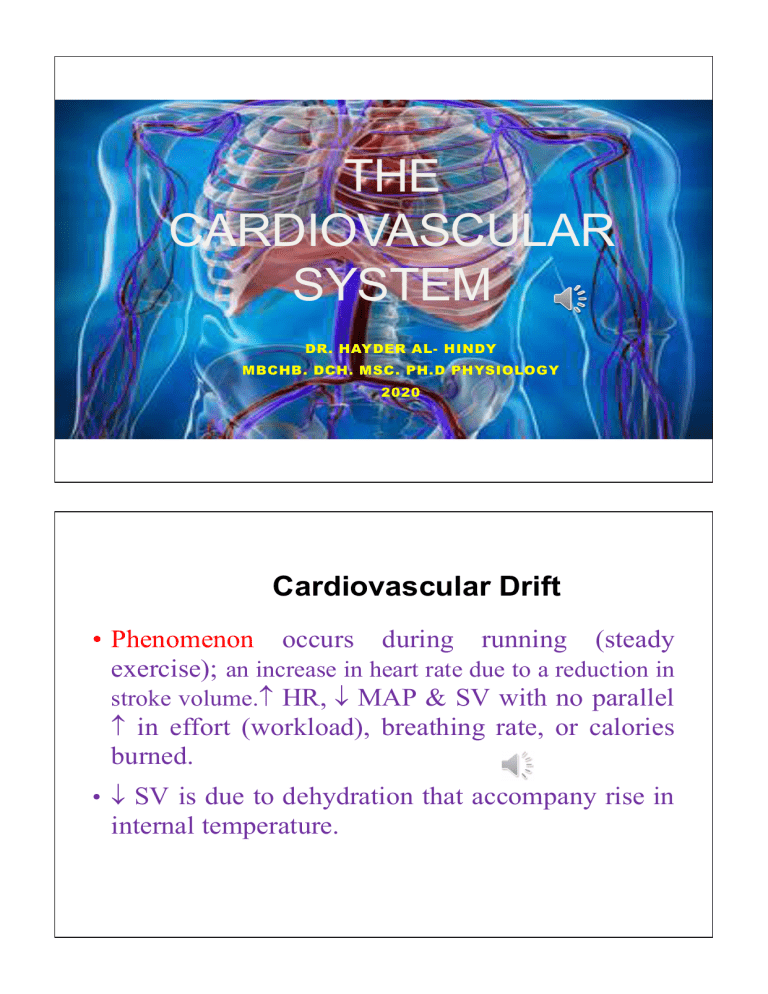
THE CARDIOVASCULAR SYSTEM DR. HAYDER AL- HINDY MBCHB. DCH. MSC. PH.D PHYSIOLOGY 2020 Cardiovascular Drift • Phenomenon occurs during running (steady exercise); an increase in heart rate due to a reduction in stroke volume. HR, MAP & SV with no parallel in effort (workload), breathing rate, or calories burned. • SV is due to dehydration that accompany rise in internal temperature. Drift is affected by factors: - Ambient temperature (more at thermal states) ، - Internal temperature, - Hydration & - Muscle mass activated. To promote cooling, blood flow to the skin (more fluids from plasma to the skin). This results in a fall in pulm. art. BP & reduced SV . To keep CO at reduced BP, the HR must be raised. Lecture Outline • • • • • Cardiovascular System Function Functional Anatomy of the Heart Myocardial Physiology Cardiac Cycle Cardiac Output Controls & Blood Pressure Cardiac Output • Cardiac Output: amount of blood pumped out of the ventricle . • The cardiac output in a resting adult is about 5 L per minute but varies greatly depending on the metabolic needs of the body. Cardiac output is computed by multiplying the stroke volume by the heart rate. Cardiac Output (CO) CO = SV X HR = 70ml X 72BPM = 5L SV = EDV- ESV = 120 – 50 = 70ml EDV = 120 ml ESV = 50 ml • The heart is able to determine its own rate & rhythm. • Stroke volume (SV) :The amount of blood ejected by the left ventricle with each heartbeat . • The average resting SV is about 70 mL, & CO can be affected by changes in either SV or HR. SV= EDV- ESV = 120 – 50 = 70ml • The percentage of the end-diastolic volume that is ejected with each stroke is called the ‘‘Ejection Fraction (EF %) (EF) = 50-70% Factors that affect stroke volume 1. Preload: Degree of stretch prior to contraction (the amount of the ventricle at end diastole) 2. Contractility: Increase in contractile strength 3. Afterload: Arterial BP, resistance to ventricular ejection HEART HOMEOSTASIS Homeostasis generally required: 1- sensing receptors 2- monitoring center 3- effector target HEART HOMEOSTASIS Effect of blood pressure • Baroreceptors monitor BP Effect of pH, carbon dioxide, oxygen • Chemoreceptors monitor Effect of extracellular ion concentration • ↑ or ↓ in extracellular K+ ↓ HR Effect of body temperature • HR ↑ when body temperature ↑ , • HR ↓ when body temperature ↓. Why is exercise good for the heart? A trained heart is bigger!! - pumps blood more efficiently (at a lower rate) stroke volume increases (due to stronger contractions, allowing for lower rate) - other benefits: higher aerobic capacity (contributing to efficiency) Note that this takes training! In order of oxygen extraction from highest to lowest: A. Heart > Brain > Kidney Cardiac Conduction Before mechanical contraction, an action potential travels quickly over each cell membrane and down into each cell’s. The Heart’s Pacemaker The parts of the heart normally beat in an orderly sequence, as described below. The heart continues to beat after all the nerves to it are sectioned. Indeed, if the heart is cut into pieces, the pieces continue to beat. The heartbeat originates in a specialized cardiac conduction system & spreads via this system discharge rhythmically because of special properties of their cell membrane & the way in which charged particles (ions) pass through it. Three physiologic features of two specialized electrical cells, the Nodal cells & the Purkinje cells, provide this synchronization: • Automaticity: ability to initiate an electrical impulse • Excitability: ability to respond to an electrical impulse • Conductivity: ability to transmit an electrical impulse from one cell to another • Contractility: Also referred to as rhythmicity, is the ability of cardiac cells to shorten and cause cardiac muscle contraction in response to an electrical stimulus. . في الم لفrId21 تعذ ر الع ثو ر ع لى جزء ال صو رة الذي له معرف العﻼقة Intrinsic Conduction System • Nodes are heart tissue that stimulate heart muscle to depolarize (contract) • Depolarization moves from base to apex • Different areas of the heart have different nodes, each with a different rate • Node rate gets slower as it moves downwards • Faster nodes will override slower nodes Intrinsic conduction of the Heart All conduction fibers connected to muscle fibers through gap junctions in the intercalated discs A D B C Resting Membrane Potential • All living cells (whether animal or plant cells) exhibit potential difference across their plasma membranes • When microelectrodes are inserted into these cells where the membrane interior is negative in relation to the membrane exterior. • This is called resting membrane potential (RMP). • Its due to uneven distribution of ions inside and outside the membrane. Resting Membrane Potential Action Potential • Myocytes are ‘‘Excitable cells’’ i.e. they have the ability to reverse the negativity of their membrane potential in response to a sufficient external stimulus. This change in membrane potential is called ‘‘action potential’’ & response is ‘‘contraction’’. Mechanism of Autorhythmicity Autorythmic cells do not have stable resting membrane potential (RMP) Natural leakiness to Na & Ca spontaneous & gradual depolarization Unstable resting membrane potential (= pacemaker potential) Gradual depolarization reaches threshold (-40 mv) spontaneous AP generation 25 Action Potential – Rapid depolarization followed by – Rapid, partial early repolarization – Prolonged period of slow repolarization which is plateau phase and – Rapid final repolarization phase Action potential in contractile fibers Action potential in contractile fibers Action Potential Autorythmic Cells (Pacemaker Cells) Characteristics of Pacemaker Cells Characteristics of Pacemaker Cells MYOCARDIAL PHYSIOLOGY: (CONTRACTILE CELLS) Skeletal Action Potential vs Contractile Myocardial Action Potential Refractory Period • During which membrane is refractory to further stimulus until contraction is over. • Lasts longer than muscle contraction (250 Vis 3 msec), prevents tetanus • Gives time to heart to: - Relax after each contraction, prevent fatigue - chambers to fill during diastol before next contraction 32 Chemoreceptor Reflex • Chemoreceptors are chemical receptors located peripherally & centrally monitor the blood pO2, pCO2 & pH, and respond immediately to alterations in these levels by causing reflex changes in respiratory rate & arterial pressure, in order to restore to normal. • ↓O2, pH, & ↑CO2 stimulate chemoreceptors to send impulses to medulla oblongata & brain to stimulate SNS that act to ↑ COP, HR, SV & cause vasoconstriction, & vise versa. The Bainbridge reflex • The Bainbridge reflex (atrial reflex): is an increase in HR due to an increase in central venous pressure. Increased blood volume is detected by stretch receptors (located in both atria at the venoatrial junctions), which leads to increased firing of B-fibers; B-fibers send signals to the brain (the afferent pathway of the neural portion of the Bainbridge reflex),. which then modulates both SNS & PSNS pathways to the SAN. Cardiac Reserve • CO is the amount of blood pumped by each ventricle in one minute Bd vol/Min • CO is the product of heart rate (HR) and stroke volume (SV) CO = HR × SV • Cardiac reserve is the difference between resting & maximal CO Cardiac reserve = Maximal CO – Resting CO -A network of tubes Blood Vessels –Arteries arterioles move away from the heart •Elastic Fibers •Circular Smooth Muscle –Capillaries – where gas exchange takes place. •One cell thick •Serves the Respiratory System –Veins Venules moves towards the heart •Skeletal Muscles contract to force blood back from legs •One way valves •When they break - varicose veins form Three Kinds of Capillaries • Continuous- lung, smooth muscle, connective tissues • Fenestrated- kidney, small intestine, brain • Sinusoids- liver red bone marrow, spleen and endocrine glands Vascular Physiology 1. Blood flow: Volume per unit time 2. Blood pressure: Force per unit area 3. Resistance: Opposition to flow; generally encountered in the systemic circuit (peripheral resistance: PR) Systemic Blood Pressure Background 1. Pumping generates blood flow 2. When flow is opposed by resistance, pressure results 3. Blood flows along a gradient from higher to lower pressure (highest in aorta & lowest in right atrium) Sources of Resistance • Blood viscosity • Total blood vessel length • B. vessel diameter resistance 1/r4 Blood Flow (F) = ∆P/PR What is hypertension? • Arterial pressure is too high • Causes is unknown, or is secondary to disease • Variety of risk factors are known: - sedentary lifestyle - smoking - obesity - diet (excess sodium; cholesterol; calories) - stress - arteriosclerosis - genetic factors What Affects BP Increases BP: Decreases BP: • • • • • • • • Atherosclerosis Thick blood Drugs/nicotine Obesity Shock/blood loss MI Drugs Physical fitness Write an essay that details a day in the life of a red blood cell as it travels through the circulatory system … where did you go and what happened Coronary Arteries • The coronary arteries are perfused during diastole. An increase in heart rate shortens diastole and can decrease myocardial perfusion. • Patients, particularly those with coronary artery disease (CAD), can develop Myocardial Ischemia (inadequate oxygen supply) when the heart rate accelerates. Atherosclerosis Atherosclerosis is due to a build-up of fatty material (plaque), mainly cholesterol, under the inner lining of arteries. The plaque can cause a thrombus (blood clot) to form. The thrombus can dislodge as an embolus and lead to thromboembolism. Atherosclerosis • Narrowing of vessel lumen due to plaque/fat formation on inside of walls • Causes: diet high in fat, cholesterol, salt; inactive lifestyle; smoking • Risk Factors: high BP, enlarged heart, embolus blocking circulation; stroke Coronary Artery Disease • When Atherosclerosis affects the arteries that supply the heart muscle • Symptoms: short of breath after simple exertion, angina (chest pain) • Risk: MI, cardiac arrest, death Myocardial Infarction • The heart has large metabolic requirements, extracting about 70% to 80% of the oxygen delivered (other organs consume, on average, 25%). Myocardial Infarction • When the coronary vessels are blocked, the heart muscle becomes starved for oxygen. • Resulting chest pain is called ‘‘angina’’. • If oxygen is deprived for a long time , the heart muscle will be damaged & death may result. HOW IS CAD TREATED? Stent – wire mesh inserted into the artery to expand its lumen Coronary Artery Bypass – arteries are removed from leg and grafted into the heart to restore circulation . Angioplasty /Coronary bypass operation 3. Lymphatic System - System of transporting vessels & nodes designed to collect fluid & proteins that leak out of the capillaries into the interstitium and return them to the blood stream proper. - Other function is immunity Effects of Aging on the Heart • Gradual changes in heart function: more at exercise • Hypertrophy of left ventricle • Maximum heart rate decreases • More valvular dysfunction & arrhythmias. • Increased O2 consumption required to pump same amount of blood Effects of Aging on the Heart • Decline in cardiac reserve – (max HR) • Fibrosis of cardiac muscle – (normal) • Atherosclerosis (You are as old as your arteries) Effects of Aging on the Vessels • Arteries & Veins – Atherosclerosis – Chances of coronary thrombosis & heart attack increase – Occurrence of varicose veins increases •Thromboembolism •Pulmonary embolism Heart & a Healthy Lifestyle Heart’s main adaptation to sustained physical activity: • Hypertrophy = increase SV = decreased resting HR • Increased potential to supply oxygen • Bradycardia = heart under less strain at rest = over lifetime could delay drop of heart = improved quality of life A Healthy Heart is a Happy Heart 1. Exercise on a regular basis. Get outside and play. Keep that body moving (walk, jog, run, bike, skate, jump, swim). 2. Eat Healthy. Remember the ‘’Food Pyramid’’ and make sure your eating your food from the bottom to top. 3. Don't Smoke! Don't Smoke! Don't Smoke! Don't Smoke! Don't Smoke! Healthy Food Pyramid THANK YOU

